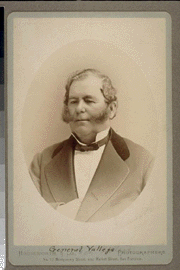Juan Manuel Vaca and Juan Felipe Pena were members of prominent Spanish families in the region around Santa Fe, New Mexico. As early as 1835 the Mexican government had authorized Commandante Vallejo

to offer free lands to settlers north of San Francisco Bay, as a protection against Russian encroachment from Fort Ross. By 1837 it was possible that our families had been in touch with Vallejo to colonize some of the land.
By 1830 trappers and traders had blazed a trail across the mountains and deserts from Santa Fe to Los Angeles, California, which was known as the Old Spanish Trail. It started northward towards Salt Lake from Santa Fe, crossed the Colorado and Green Rivers above their junctions in Utah, turned south-west through the mountains, across the Nevada deserts, through the Mojave Desert in California and into Los Angeles. The trail was 1200 miles that could be traveled only by horseback or pack mules.
For 18 years this route had been used by traders who used it to carry goods to California. Travelers to the Pacific coast joined these traders for protection from hostile Indians.
On September 6, 1841, some 25 immigrants joined the group and left Abiquiu, New Mexico, north of Santa Fe. Among them were the Vaca and Pena families. History now records this as the Workman-Rowland party. William Workman and John Rowland were prominent merchants who had joined the party at Abiquiu in time to escape accusations as traitors by Governor Manuel Armijo of New Mexico.
Because of the size of the caravan, they did not suffer from attack from hostile Indians. Due to desert conditions the trip was made in the Fall when there was feed for the animals to graze on, as well as water-holes along the trail.
According to family accounts of the journey, 150 sheep were purchased to be driven along and killed as needed for food. Also, a grand-daughter named Nestora, at the age of three, was carried at times on a pillow on her father's horse. Also, another daughter, age two, rode on a balanced saddlebag opposite Nestora, on a gentle mule.
After their arriva at the Mission San Gabriel (Los Angeles), they followed El Camino Real to Monterey, then on to Death Valley near Sacramento.
It is not known how the families crossed the waters of San Francisco Bay or the Straits of Carquenz as no ferry large enough was available for transporting horses or mules. An earlier account relates that the animals were tied to rafts and forced to swim across.
General Vallejo, in 1840, was using a small ferry to cross San Francisco Bay, but it did not cary animals. It is possible that the early settlers may have left their horses south of the Bay and were given fresh animals by Commandante Vallejo. At that time Vallejo owned 1,000 broken horses and from 6,000 to 8,000 unbroken.
The hospitable Commandante vallejo kept the women and children at Sonoma, his home, while the men continued on their way to guild homes on their new land grant, a distance of about 40 miles, less than a day's horseback ride to what became known as Laguna Valley.
Two months after leaving Abiquiu, New Mexico, the arrival of the Workman-Rowland party is recorded by historian Bancroft as November 18, 1841.
There were six children in the Juan Felipe family, and eight children in the Juan Manuel Vaca family.
No comments:
Post a Comment